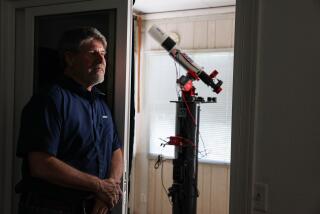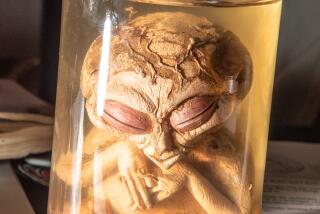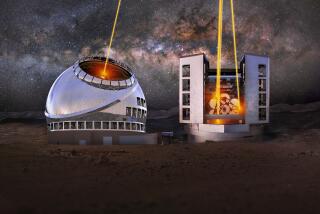Astronomy Finally Comes Down to Earth
Naturally, I read the front-page news that radio astronomers have discovered a new planet, in some solar system like really far away, wobbling around something called a pulsar (not the kind made by Nissan), with considerable interest.
The more the merrier, as far as I’m concerned.
Then I read this: “And if it turns out that there is no planet, the pulsar it is believed to be orbiting must be a very bizarre object, scientists said.”
Which, of course, explains everything.
Just when I thought that things such as science were way over the heads of the average American, comes the eye-opening realization that all it takes to become a “highly respected expert in radio astronomy” is, uh, an open mind.
I’ve heard about this. I sometimes even get letters--jerky longhand, with lots of writing in the margins--from people whose minds are so open that they sometimes have trouble tuning out all the static.
(Seems that the CIA implanted faulty receptors in their brains while they are napping or something.
(Hey, maybe these radio astronomers are the same guys who invented the Hubble telescope? Just a thought . . . . )
Anyway, what I’m saying here is that radio astronomy sounds like something that even I, without, er, any solid grounding in the physical sciences, can grasp.
For starters, I am familiar with Very Bizarre Objects.
Just the other day, my daughter came home with one from preschool. It had feathers and dried leaves and glued-on, uncooked macaroni, and perhaps: feet. And she came up with the concept all by herself!
Which just goes to show that it is never too early to instill in our young people a healthy curiosity about the wonders of science. It can really pay off in the long run.
Because if I understand things correctly, there is still time for today’s youth to grow up to save the world or, failing that, die with the satisfaction of having told us so.
I am referring, of course, to a future in another of my favorite branches of astronomy, that having to do with asteroids.
Those of you tuned into these kinds of things will recall that around the time the rest of us were watching what we thought were fireworks on the Fourth of July, scientific experts were meeting in San Juan Capistrano to bat about the odds of a large asteroid crashing to Earth, ANY MINUTE NOW, (wiping out life on the planet)--or maybe just a smaller one that would take care of, say, Los Angeles, once and for all.
Not that this is any cause for alarm.
Because, I tell you, if there is any one group of people that you would want to entrust the future of the planet to, or heck, even Los Angeles to, it is astronomers. They are true visionaries.
Spending all that time with your head in the clouds will do that to you. It lets you see things in a whole new light.
For example: After reading accounts of San Juan Capistrano meeting, I now know that a large asteroid hurtling toward Earth--the same kind that probably completely surprised the dinosaurs with instant extinction after 150 million years of the same old day-in-and-day-out kind of grind--is really nothing to get worked up about.
Because the feeling among the astronomers is that they’d definitely see something like that coming.
A large asteroid connects with Earth about, oh, about once every 10 million years, and the astronomers figure they’d know it when they see it. Then they’d tell the rest of us, just as soon as they could, but probably with plenty of time left to get all those T-shirts, commemorative mugs and posters made up.
Or maybe, no doubt after we get the kinks ironed out of the Star Wars defense system, they could convince the powers that be to send a rocket up there and nudge the asteroid out of the way.
Please note that I am not making any of this up. I never even touch Nintendo.
Now, with the smaller asteroids, you’re talking about connecting with Earth every few hundred years or so. This could be more of a problem, but as I say, I have faith in astronomy.
The key seems to be telescopes, which the dinosaurs never even dreamed about.
As a matter of fact, at any given moment hundreds of telescopes are turned toward the skies, telescopes that one would think would certainly catch something like an asteroid, even though a couple of years back one did manage to escape detection until it was within a piddling 400,000 miles of Earth.
This apparently bothered a lot of people, but, hey, we’re still here aren’t we?
Besides, the next one, for sure, will be dealt with properly. The astronomers at the San Juan Capistrano meeting said that we could just blow that baby up, although others said that would mean that instead of one asteroid, you’d have lots of asteroid bits “that would rain down terror over a wider area.”
Which might be a problem.
But, according to John Pike, director of the Space Policy Project for the Federation of American Scientists, there is still one recourse: Evacuation. Except that figuring out exactly where an asteroid may hit could be kind of tricky.
Best estimate now is that maybe they’d know to within “a few tens of kilometers” and so, some of the scientists said that if that were the best they could do--not to mention the time and effort it would take to teach Americans the metric system!--well, then they would just keep the news to themselves “in hopes of avoiding public hysteria.”
Which, come to think of it, might not be such a bad idea. How about we forget I ever mentioned it?
Dianne Klein’s column appears Tuesday, Thursday and Sunday. Readers may reach Klein by writing to her at The Times Orange County Edition, 1375 Sunflower Ave., Costa Mesa, Calif. 92626, or calling (714) 966-7406.






